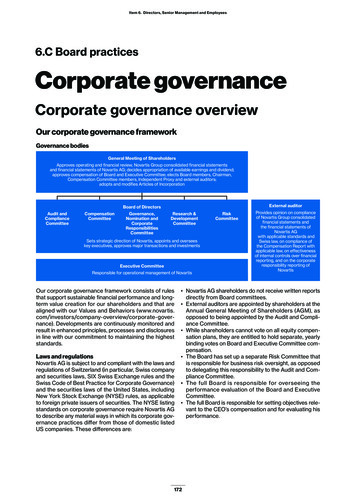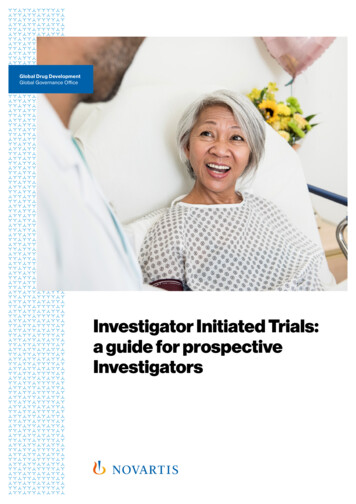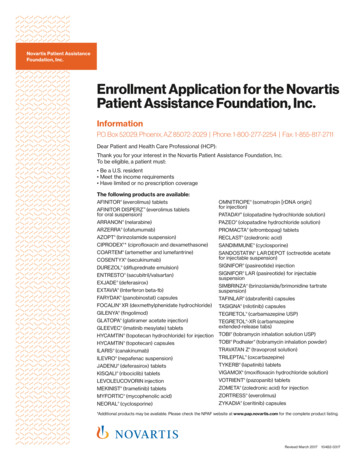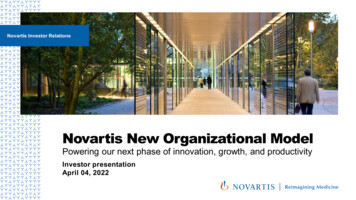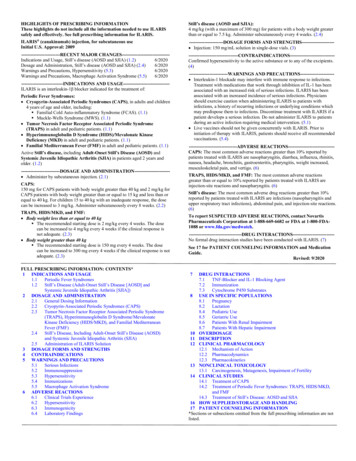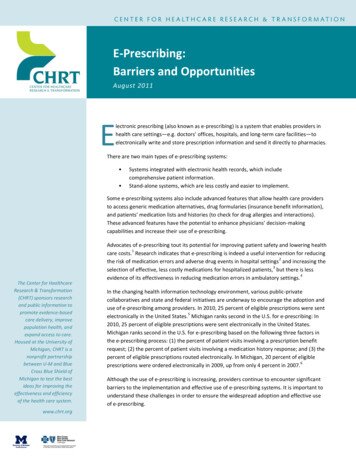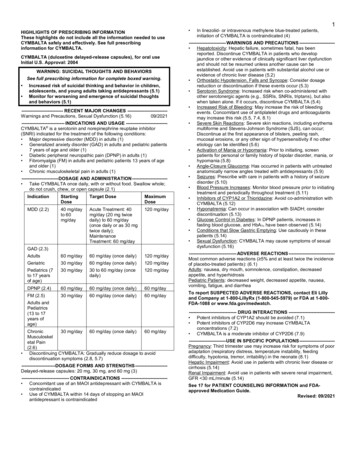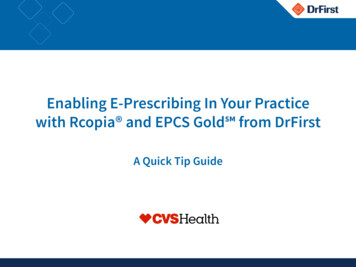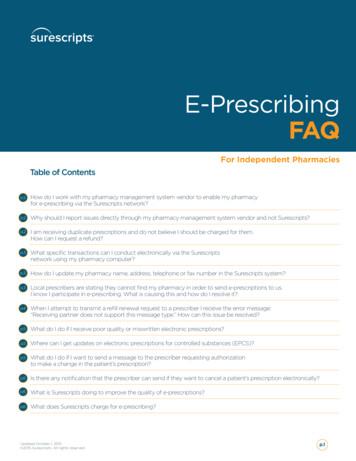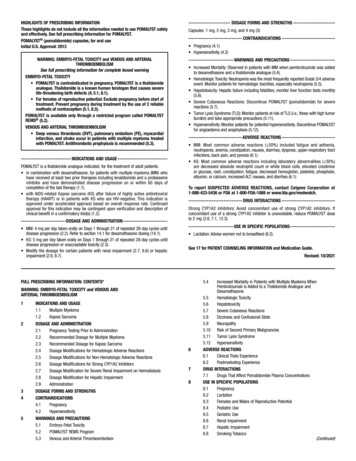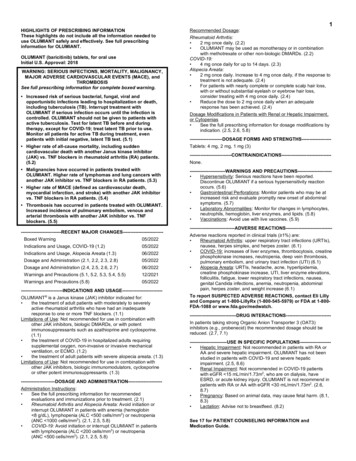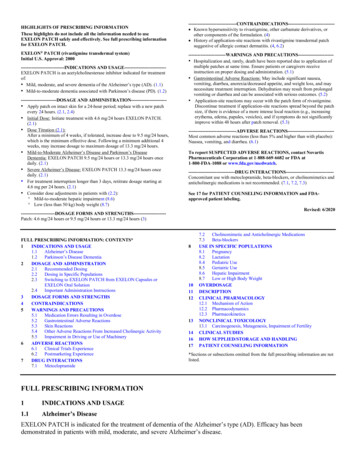
Transcription
HIGHLIGHTS OF PRESCRIBING INFORMATIONThese highlights do not include all the information needed to useEXELON PATCH safely and effectively. See full prescribing informationfor EXELON PATCH.EXELON PATCH (rivastigmine transdermal system)Initial U.S. Approval: 2000----------------------------INDICATIONS AND USAGE--------------------------EXELON PATCH is an acetylcholinesterase inhibitor indicated for treatmentof: Mild, moderate, and severe dementia of the Alzheimer’s type (AD). (1.1) Mild-to-moderate dementia associated with Parkinson’s disease (PD). (1.2)-----------------------DOSAGE AND ADMINISTRATION---------------------- Apply patch on intact skin for a 24-hour period; replace with a new patchevery 24 hours. (2.1, 2.4) Initial Dose: Initiate treatment with 4.6 mg/24 hours EXELON PATCH.(2.1) Dose Titration (2.1):After a minimum of 4 weeks, if tolerated, increase dose to 9.5 mg/24 hours,which is the minimum effective dose. Following a minimum additional 4weeks, may increase dosage to maximum dosage of 13.3 mg/24 hours. Mild-to-Moderate Alzheimer’s Disease and Parkinson’s DiseaseDementia: EXELON PATCH 9.5 mg/24 hours or 13.3 mg/24 hours oncedaily. (2.1) Severe Alzheimer’s Disease: EXELON PATCH 13.3 mg/24 hours oncedaily. (2.1) For treatment interruption longer than 3 days, retitrate dosage starting at4.6 mg per 24 hours. (2.1) Consider dose adjustments in patients with (2.2): Mild-to-moderate hepatic impairment (8.6) Low (less than 50 kg) body weight ONS----------------------------- Known hypersensitivity to rivastigmine, other carbamate derivatives, orother components of the formulation. (4) History of application-site reactions with rivastigmine transdermal patchsuggestive of allergic contact dermatitis. (4, 6.2)------------------------WARNINGS AND PRECAUTIONS---------------------- Hospitalization and, rarely, death have been reported due to application ofmultiple patches at same time. Ensure patients or caregivers receiveinstruction on proper dosing and administration. (5.1) Gastrointestinal Adverse Reactions: May include significant nausea,vomiting, diarrhea, anorexia/decreased appetite, and weight loss, and maynecessitate treatment interruption. Dehydration may result from prolongedvomiting or diarrhea and can be associated with serious outcomes. (5.2) Application-site reactions may occur with the patch form of rivastigmine.Discontinue treatment if application-site reactions spread beyond the patchsize, if there is evidence of a more intense local reaction (e.g., increasingerythema, edema, papules, vesicles), and if symptoms do not significantlyimprove within 48 hours after patch removal. (5.3)-------------------------------ADVERSE REACTIONS-----------------------------Most common adverse reactions (less than 5% and higher than with placebo):Nausea, vomiting, and diarrhea. (6.1)To report SUSPECTED ADVERSE REACTIONS, contact NovartisPharmaceuticals Corporation at 1-888-669-6682 or FDA at1-800-FDA-1088 or -DRUG ant use with metoclopramide, beta-blockers, or cholinomimetics andanticholinergic medications is not recommended. (7.1, 7.2, 7.3)See 17 for PATIENT COUNSELING INFORMATION and FDAapproved patient labeling.Revised: 6/2020----------------------DOSAGE FORMS AND STRENGTHS--------------------Patch: 4.6 mg/24 hours or 9.5 mg/24 hours or 13.3 mg/24 hours (3)FULL PRESCRIBING INFORMATION: CONTENTS*1INDICATIONS AND USAGE1.1Alzheimer’s Disease1.2Parkinson’s Disease Dementia2DOSAGE AND ADMINISTRATION2.1Recommended Dosing2.2Dosing in Specific Populations2.3Switching to EXELON PATCH from EXELON Capsules orEXELON Oral Solution2.4Important Administration Instructions3DOSAGE FORMS AND STRENGTHS4CONTRAINDICATIONS5WARNINGS AND PRECAUTIONS5.1Medication Errors Resulting in Overdose5.2Gastrointestinal Adverse Reactions5.3Skin Reactions5.4Other Adverse Reactions From Increased Cholinergic Activity5.5Impairment in Driving or Use of Machinery6ADVERSE REACTIONS6.1Clinical Trials Experience6.2Postmarketing Experience7DRUG linomimetic and Anticholinergic Medications7.3Beta-blockersUSE IN SPECIFIC POPULATIONS8.1Pregnancy8.2Lactation8.4Pediatric Use8.5Geriatric Use8.6Hepatic Impairment8.7Low or High Body WeightOVERDOSAGEDESCRIPTIONCLINICAL PHARMACOLOGY12.1 Mechanism of Action12.2 Pharmacodynamics12.3 PharmacokineticsNONCLINICAL TOXICOLOGY13.1 Carcinogenesis, Mutagenesis, Impairment of FertilityCLINICAL STUDIESHOW SUPPLIED/STORAGE AND HANDLINGPATIENT COUNSELING INFORMATION*Sections or subsections omitted from the full prescribing information are notlisted.FULL PRESCRIBING INFORMATION1INDICATIONS AND USAGE1.1Alzheimer’s DiseaseEXELON PATCH is indicated for the treatment of dementia of the Alzheimer’s type (AD). Efficacy has beendemonstrated in patients with mild, moderate, and severe Alzheimer’s disease.
1.2Parkinson’s Disease DementiaEXELON PATCH is indicated for the treatment of mild-to-moderate dementia associated with Parkinson’sdisease (PDD).2DOSAGE AND ADMINISTRATION2.1Recommended DosingInitial DoseInitiate treatment with one 4.6 mg/24 hours EXELON PATCH applied to the skin once daily [see Dosage andAdministration (2.4)].Dose TitrationIncrease the dose only after a minimum of 4 weeks at the previous dose, and only if the previous dose has beentolerated. For mild-to-moderate AD and PDD patients, continue the effective dose of 9.5 mg/24 hours for as longas therapeutic benefit persists. Patients can then be increased to the maximum effective dose of 13.3 mg/24 hoursdose. For patients with severe AD, 13.3 mg/24 hours is the effective dose. Doses higher than 13.3 mg/24 hoursconfer no appreciable additional benefit, and are associated with an increase in the incidence of adverse reactions[see Warnings and Precautions (5.2), Adverse Reactions (6.1)].Mild-to-Moderate Alzheimer’s Disease and Mild-to-Moderate Parkinson’s Disease DementiaThe effective dosage of EXELON PATCH is 9.5 mg/24 hours or 13.3 mg/24 hours administered once per day;replace with a new patch every 24 hours.Severe Alzheimer’s DiseaseThe effective dosage of EXELON PATCH in patients with severe Alzheimer’s disease is 13.3 mg/24 hoursadministered once per day; replace with a new patch every 24 hours.Interruption of TreatmentIf dosing is interrupted for 3 days or fewer, restart treatment with the same or lower strength EXELON PATCH.If dosing is interrupted for more than 3 days, restart treatment with the 4.6 mg/24 hours EXELON PATCH andtitrate as described above.2.2Dosing in Specific PopulationsDosing Modifications in Patients with Hepatic ImpairmentConsider using the 4.6 mg/24 hours EXELON PATCH as both the initial and maintenance dose in patients withmild (Child-Pugh score 5 to 6) to moderate (Child-Pugh score 7 to 9) hepatic impairment [see Use in SpecificPopulations (8.6), Clinical Pharmacology (12.3)].Dosing Modifications in Patients with Low Body WeightCarefully titrate and monitor patients with low body weight (less than 50 kg) for toxicities (e.g., excessive nausea,vomiting), and consider reducing the maintenance dose to the 4.6 mg/24 hours EXELON PATCH if suchtoxicities develop.2.3Switching to EXELON PATCH from EXELON Capsules or EXELON Oral SolutionPatients treated with EXELON Capsules or Oral Solution may be switched to EXELON PATCH as follows: A patient who is on a total daily dose of less than 6 mg of oral rivastigmine can be switched to the 4.6 mg/24hours EXELON PATCH. A patient who is on a total daily dose of 6 mg to 12 mg of oral rivastigmine can be switched to the 9.5 mg/24hours EXELON PATCH.Instruct patients or caregivers to apply the first patch on the day following the last oral dose.2.4Important Administration InstructionsEXELON PATCH is for transdermal use on intact skin.
(a) Do not use the patch if the pouch seal is broken or the patch is cut, damaged, or changed in any way.(b) Apply the EXELON PATCH once a day. Press down firmly for 30 seconds until the edges stick well when applying to clean, dry, hairless, intacthealthy skin in a place that will not be rubbed against by tight clothing. Use the upper or lower back as the site of application because the patch is less likely to be removed by thepatient. If sites on the back are not accessible, apply the patch to the upper arm or chest. Do not apply to a skin area where cream, lotion, or powder has recently been applied.(c) Do not apply to skin that is red, irritated, or cut.(d) Replace the EXELON PATCH with a new patch every 24 hours. Instruct patients to only wear 1 patch at atime (remove the previous day’s patch before applying a new patch) [see Warnings and Precautions (5.1),Overdosage (10)]. If a patch falls off or if a dose is missed, apply a new patch immediately, and then replace thispatch the following day at the usual application time.(e) Change the site of patch application daily to minimize potential irritation, although a new patch can be appliedto the same general anatomic site (e.g., another spot on the upper back) on consecutive days. Do not apply a newpatch to the same location for at least 14 days.(f) May wear the patch during bathing and in hot weather. Avoid long exposure to external heat sources(excessive sunlight, saunas, solariums).(g) Place used patches in the previously saved pouch and discard in the trash, away from pets or children.(h) Wash hands with soap and water after removing the patch. In case of contact with eyes or if the eyes becomered after handling the patch, rinse immediately with plenty of water, and seek medical advice if symptoms do notresolve.3DOSAGE FORMS AND STRENGTHSEXELON PATCH is available in 3 strengths. Each patch has a beige backing layer labeled as either: EXELON PATCH 4.6 mg/24 hours, AMCX EXELON PATCH 9.5 mg/24 hours, BHDI EXELON PATCH 13.3 mg/24 hours, CNFU4CONTRAINDICATIONSEXELON PATCH is contraindicated in patients with: known hypersensitivity to rivastigmine, other carbamate derivatives, or other components of the formulation[see Description (11)] previous history of application-site reactions with rivastigmine transdermal patch suggestive of allergic contactdermatitis [see Warnings and Precautions (5.3)].Isolated cases of generalized skin reactions have been described in postmarketing experience [see AdverseReactions (6.2)].5WARNINGS AND PRECAUTIONS5.1Medication Errors Resulting in OverdoseMedication errors with EXELON PATCH have resulted in serious adverse reactions; some cases have requiredhospitalization, and rarely, led to death. The majority of medication errors have involved not removing the oldpatch when putting on a new one and the use of multiple patches at one time.Instruct patients and their caregivers on important administration instructions for EXELON PATCH [see Dosageand Administration (2.4)].
5.2Gastrointestinal Adverse ReactionsEXELON PATCH can cause gastrointestinal adverse reactions, including significant nausea, vomiting, diarrhea,anorexia/decreased appetite, and weight loss. Dehydration may result from prolonged vomiting or diarrhea andcan be associated with serious outcomes. The incidence and severity of these reactions are dose-related [seeAdverse Reactions (6.1)]. For this reason, initiate treatment with EXELON PATCH at a dose of 4.6 mg/24 hours,and titrate to a dose of 9.5 mg/24 hours and then to a dose of 13.3 mg/24 hours, if appropriate [see Dosage andAdministration (2.1)].If treatment is interrupted for more than 3 days because of intolerance, reinitiate EXELON PATCH with the 4.6mg/24 hours dose to reduce the possibility of severe vomiting and its potentially serious sequelae. Apostmarketing report described a case of severe vomiting with esophageal rupture following inappropriatereinitiation of treatment of an oral formulation of rivastigmine without retitration after 8 weeks of treatmentinterruption.Inform caregivers to monitor for gastrointestinal adverse reactions and to inform the physician if they occur. It iscritical to inform caregivers that if therapy has been interrupted for more than 3 days because of intolerance, thenext dose should not be administered without contacting the physician regarding proper retitration.5.3Skin ReactionsSkin application-site reactions may occur with EXELON PATCH. These reactions are not in themselves anindication of sensitization. However, use of rivastigmine patch may lead to allergic contact dermatitis.Allergic contact dermatitis should be suspected if application-site reactions spread beyond the patch size, if thereis evidence of a more intense local reaction (e.g., increasing erythema, edema, papules, vesicles), and if symptomsdo not significantly improve within 48 hours after patch removal. In these cases, treatment should be discontinued[see Contraindications (4)].In patients who develop application-site reactions to EXELON PATCH, suggestive of allergic contact dermatitisand who still require rivastigmine, treatment should be switched to oral rivastigmine only after negative allergytesting and under close medical supervision. It is possible that some patients sensitized to rivastigmine byexposure to rivastigmine patch may not be able to take rivastigmine in any form.There have been isolated postmarketing reports of patients experiencing disseminated allergic dermatitis whenadministered rivastigmine irrespective of the route of administration (oral or transdermal). In these cases,treatment should be discontinued [see Contraindications (4)]. Patients and caregivers should be instructedaccordingly.5.4Other Adverse Reactions From Increased Cholinergic ActivityNeurologic EffectsExtrapyramidal Symptoms: Cholinomimetics, including rivastigmine, may exacerbate or induce extrapyramidalsymptoms. Worsening of parkinsonian symptoms, particularly tremor, has been observed in patients withdementia associated with Parkinson’s disease who were treated with EXELON Capsules.Seizures: Drugs that increase cholinergic activity are believed to have some potential for causing seizures.However, seizure activity also may be a manifestation of Alzheimer's disease.Peptic Ulcers/Gastrointestinal BleedingCholinesterase inhibitors, including rivastigmine, may increase gastric acid secretion due to increased cholinergicactivity. Monitor patients using EXELON PATCH for symptoms of active or occult gastrointestinal bleeding,especially those at increased risk for developing ulcers, e.g., those with a history of ulcer disease or thosereceiving concurrent nonsteroidal anti-inflammatory drugs (NSAIDs). Clinical studies of rivastigmine haveshown no significant increase, relative to placebo, in the incidence of either peptic ulcer disease or gastrointestinalbleeding.Use with AnesthesiaRivastigmine, as a cholinesterase inhibitor, is likely to exaggerate succinylcholine-type muscle relaxation duringanesthesia.Cardiac Conduction Effects
Because rivastigmine increases cholinergic activity, use of the EXELON PATCH may have vagotonic effects onheart rate (e.g., bradycardia). The potential for this action may be particularly important in patients with sick sinussyndrome or other supraventricular cardiac conduction conditions. In clinical trials, rivastigmine was notassociated with any increased incidence of cardiovascular adverse events, heart rate or blood pressure changes, orelectrocardiogram (ECG) abnormalities.Genitourinary EffectsAlthough not observed in clinical trials of rivastigmine, drugs that increase cholinergic activity may cause urinaryobstruction.Pulmonary EffectsDrugs that increase cholinergic activity, including EXELON PATCH, should be used with care in patients with ahistory of asthma or obstructive pulmonary disease.5.5Impairment in Driving or Use of MachineryDementia may cause gradual impairment of driving performance or compromise the ability to use machinery. Theadministration of rivastigmine may also result in adverse reactions that are detrimental to these functions. Duringtreatment with EXELON PATCH, routinely evaluate the patient’s ability to continue driving or operatingmachinery.6ADVERSE REACTIONSThe following adverse reactions are described below and elsewhere in the labeling: Gastrointestinal Adverse Reactions [see Warnings and Precautions (5.2)] Skin Reactions [see Warnings and Precautions (5.3)] Other Adverse Reactions from Increased Cholinergic Activity [see Warnings and Precautions (5.4)]6.1Clinical Trials ExperienceBecause clinical trials are conducted under widely varying conditions, adverse reaction rates observed in theclinical trials of a drug cannot be directly compared to rates in the clinical trials of another drug and may notreflect the rates observed in practice.EXELON PATCH has been administered to 4516 patients with Alzheimer’s disease during clinical trialsworldwide. Of these, 3005 patients have been treated for at least 26 weeks, 1771 patients have been treated for atleast 52 weeks, 974 patients have been treated for at least 78 weeks, and 24 patients have been treated for at least104 weeks.Mild-to-Moderate Alzheimer’s Disease24-Week International Placebo-Controlled Trial (Study 1)Most Common Adverse ReactionsThe most common adverse reactions in patients administered EXELON PATCH in Study 1 [see Clinical Studies(14)], defined as those occurring at a frequency of at least 5% in the 9.5 mg/24 hours EXELON PATCH arm andat a frequency at higher than in the placebo group, were nausea, vomiting, and diarrhea. These reactions weredose-related, with each being more common in patients using the unapproved 17.4 mg/24 hours EXELONPATCH than in those using the 9.5 mg/24 hours EXELON PATCH.Discontinuation RatesIn Study 1, which randomized a total of 1195 patients, the proportions of patients in the EXELON PATCH9.5 mg/24 hours, EXELON Capsules 6 mg twice daily, and placebo groups who discontinued treatment due toadverse events were 10%, 8%, and 5%, respectively.The most common adverse reactions in the EXELON PATCH-treated groups that led to treatment discontinuationin this study were nausea and vomiting. The proportions of patients who discontinued treatment due to nauseawere 0.7%, 1.7%, and 1.3% in the EXELON PATCH 9.5 mg/24 hours, EXELON Capsules 6 mg twice daily, andplacebo groups, respectively. The proportions of patients who discontinued treatment due to vomiting were 0%,
2.0%, and 0.3% in the EXELON PATCH 9.5 mg/24 hours, EXELON Capsules 6 mg twice daily, and placebogroups, respectively.Adverse Reactions Observed at an Incidence of Greater than or Equal to 2%Table 1 lists adverse reactions seen at an incidence of greater than or equal to 2% in either EXELON PATCHtreated group in Study 1, and for which the rate of occurrence was greater for patients treated with that dose ofEXELON PATCH than for those treated with placebo. The unapproved 17.4 mg/24 hours EXELON PATCH armis included to demonstrate the increased rates of gastrointestinal adverse reactions over those seen with the 9.5mg/24 hours EXELON PATCH.Table 1: Proportion of Adverse Reactions Observed With a Frequency of Greater Than or Equal to 2%and Occurring at a Rate Greater Than Placebo in Study 1EXELONPATCH9.5 mg/24 hoursTotal Patients StudiedTotal Percentage of Patients with ARs yAnorexia/Decreased AppetiteWeight Decreased**DizzinessAbdominal PainUrinary Tract InfectionAstheniaFatigueInsomniaAbdominal Pain UpperVertigoEXELONEXELONPlaceboPATCHCapsule17.4 mg/24 hours 6 mg twice iation: ARs, adverse reactions.*Vomiting was severe in 0% of patients who received EXELON PATCH 9.5 mg/24 hours, 1% of patients who received EXELON PATCH17.4 mg/24 hours, 1% of patients who received the EXELON Capsule at doses up to 6 mg twice daily, and 0% of those who receivedplacebo.**Weight Decreased as presented in Table 1 is based upon clinical observations and/or adverse events reported by patients or caregivers.Body weight was also monitored at prespecified time points throughout the course of the clinical study. The proportion of patients who hadweight loss equal to or greater than 7% of their baseline weight was 8% of those treated with EXELON PATCH 9.5 mg/24 hours, 12% ofthose treated with EXELON PATCH 17.4 mg/24 hours, 11% of patients who received the EXELON Capsule at doses up to 6 mg twicedaily and 6% of those who received placebo. It is not clear how much of the weight loss was associated with anorexia, nausea, vomiting,and the diarrhea associated with the drug.48-Week International Active Comparator-Controlled Trial (Study 2)Most Common Adverse ReactionsIn Study 2 [see Clinical Studies (14)] of the commonly observed adverse reactions (greater than or equal to 3% inany treatment group), the most frequent event in the EXELON PATCH 13.3 mg/24 hours group was nausea,followed by vomiting, fall, weight decreased, application-site erythema, decreased appetite, diarrhea and urinarytract infection (Table 3). The percentage of patients with these events was higher in the EXELON PATCH 13.3mg/24 hours group than in the EXELON PATCH 9.5 mg/24 hours group. Patients with nausea, vomiting, diarrheaand decreased appetite experienced these reactions more often during the first 4 weeks of the double-blind
treatment phase. These reactions decreased over time in each treatment group. Weight decreased was reported tohave increased over time in each treatment group.Discontinuation RatesTable 2 displays the most common adverse reactions leading to discontinuation during the 48-week, double-blindtreatment phase in Study 2.Table 2: Proportion of Most Common Adverse Reactions (greater than 1% at any dose) Leading toDiscontinuation During 48-week Double-Blind Treatment Phase in Study 2Total Patients StudiedTotal Percentage of Patients with ARs Leading toDiscontinuation (%)VomitingApplication-site pruritusAggressionEXELONPATCH13.3 mg/24 hoursEXELONPATCH9.5 mg/24 91.10.7Abbreviation: ARs, adverse reactions.Most Common Adverse Reactions Greater than or Equal to 3%Other adverse reactions of interest which occurred less frequently, but which were observed in a markedly higherpercentage of patients in the EXELON PATCH 13.3 mg/24 hours group than in the EXELON PATCH 9.5 mg/24hours group in Study 2, included dizziness and upper abdominal pain. The percentage of patients with thesereactions decreased over time in each treatment group (Table 3). The adverse reaction severity profile wasgenerally similar for both the EXELON PATCH 13.3 mg/24 hours and 9.5 mg/24 hours groups.
Table 3: Proportion of Adverse Reactions Over Time in the 48-week Double-Blind Treatment Phase (atleast 3% in any treatment group) in Study 2Cumulative Week 0 to 48(DB Phase)Preferred TermTotal Patients StudiedTotal Percentage ofPatients with ARs (%)NauseaVomitingFallWeight decreased*Application-site erythemaDecreased appetiteDiarrheaUrinary tract ite pruritusHeadacheInsomniaAbdominal pain upperAnxietyHypertensionUrinary incontinencePsychomotor hyperactivityAggressionWeek 0 to 24(DB Phase)Week 24 to 48(DB Phase)EXELONPATCH13.3 mg/24hoursEXELONPATCH9.5 mg/24hoursEXELONPATCH13.3 mg/24hoursEXELONPATCH9.5 mg/24hoursEXELONPATCH13.3 mg/24hoursEXELONPATCH9.5 2214341524333 134112213343451223132 1 1312112122322 1 1222 11 12 111 111Abbreviations: DB, double blind; ARs, adverse reactions.*Decreased Weight as presented in Table 3 is based upon clinical observations and/or adverse events reported by patients or caregivers.Body weight was monitored as a vital sign at pre-specified time points throughout the course of the clinical study. The proportion ofpatients who had weight loss equal to or greater than 7% of their baseline weight was 15.2% of those treated with EXELON PATCH9.5 mg/24 hours and 18.6% of those treated with EXELON PATCH 13.3 mg/24 hours during the 48-week double-blind treatment period.Severe Alzheimer’s Disease24-Week US Controlled Trial (Study 3)Most Commonly Observed Adverse ReactionsThe most common adverse reactions in patients administered EXELON PATCH in the controlled clinical trial,defined as those occurring at a frequency of at least 5% in the 13.3 mg/24 hours EXELON PATCH arm and at afrequency higher than in the 4.6 mg/24 hours EXELON PATCH were application-site erythema, fall, insomnia,vomiting, diarrhea, weight decreased, and nausea (Table 4). Patients in the lower-dose group reported more eventsof agitation, urinary tract infection, and hallucinations than patients in the higher-dose group.
Discontinuation RatesIn Study 3 [see Clinical Studies (14)], the proportions of patients in the EXELON PATCH 13.3 mg/24 hours (n 355) and EXELON PATCH 4.6 mg/24 hours (n 359), who discontinued treatment due to adverse reactions were21% and 14%, respectively.The most frequent adverse reaction leading to discontinuation in the 13.3 mg/24 hours treatment group versus the4.6 mg/24 hours treatment group was agitation (2.8% versus 2.2%), followed by vomiting (2.5% and 1.1%),nausea (1.7% and 1.1%), decreased appetite (1.7% and 0%), aggression (1.1% and 0.3%), fall (1.1% and 0.3%)and syncope (1.1% and 0.3%). Otherwise, all AEs leading to discontinuation were reported in less than 1% ofpatients.Most Commonly Observed Adverse Reactions Greater than or Equal to 5%Other adverse reactions of interest, which were observed in a higher percentage of patients in the EXELONPATCH 13.3 mg/24 hours group than in the EXELON PATCH 4.6 mg/24 hours group, included application-siteerythema, fall, insomnia, vomiting, diarrhea, weight decreased, and nausea (Table 4). Overall, the majority ofpatients in this study experienced adverse reactions that were mild (30.7%) or moderate (32.1%) in severity.Slightly more patients in the 4.6 mg/24 hours patch group reported mild events than in the 13.3 mg/24 hours patchgroup, while the numbers of patients reporting moderate events were comparable between groups. Severe adversereactions were reported at a slightly higher percentage at the higher dose (12.4%) than at the lower-dose (10%)treatment groups. With the exception of severe adverse reactions of agitation (13.3 mg: 1.1%; 4.6 mg: 1.4%), fall(13.3 mg: 1.1%) and urinary tract infection (4.6 mg: 1.1%), all adverse reactions reported as severe occurred inless than 1% of patients in either treatment group.Table 4: Proportion of Adverse Reactions in the 24-week Double-BlindTreatment Phase (at least 5% in anytreatment group) in Study 3Preferred termTotal number of patients studiedTotal percentage of patients with ARs (%)Application-site erythemaAgitationUrinary tract infectionFallInsomniaVomitingDiarrheaWeight decreased*NauseaDepressionDecreased appetiteAnxietyHallucinationEXELON PATCH13.3 mg/24 hours35575131288777765552EXELON PATCH4.6 mg/24 hours359731214106435334155Abbreviation: ARs, adverse reactions.*Weight Decreased as presented in Table 4 is based upon clinical observations and/or adverse events reported by patients or caregivers.Body weight was monitored as a vital sign at prespecified time points throughout the course of the clinical study. The proportion of patientswho had weight loss equal to or greater than 7% of their baseline weight was 11% of those treated with EXELON PATCH 4.6 mg/24 hoursand 14.1% of those treated with EXELON PATCH 13.3 mg/24 hours during the 24-week double-blind treatment.Application-Site ReactionsApplication-site skin reactions leading to discontinuation were observed in less than or equal to 2.3% ofEXELON PATCH patients. This number was 4.9% and 8.4% in the Chinese population and Japanese population,respectively.
Cases of skin irritation were captured separately on an investigator-rated skin irritation scale. Skin irritation, whenobserved, was mostly slight or mild in severity and was rated as severe in less than or equal to 2.2% of EXELONPATCH patients in a double-blind controlled study and in less than or equal to 3.7% of EXELON PATCHpatients in a double-blind controlled study in Japanese patients.Parkinson’s Disease Dementia76-week International Open-Label Trial (Study 4)EXELON PATCH has been administered to 288 patients with mild-to-moderate Parkinson’s Disease Dementia ina single, 76-week, open-label, active-comparator safety study. Of these, 256 have been treated for at least 12weeks, 232 for at least 24 weeks, and 196 for at least 52 weeks.Treatment with EXELON PATCH was initiated at 4.6 mg/24 hours and if tolerated the dose was increased after 4weeks to 9.5 mg/24 hours. EXELON Capsule (target maintenance dose of 12 mg/day) served as the activecomparator and was administered to 294 patients. Adverse reactions are presented in Table 5.Table 5: Proportion of Adverse Reactions Reported at a Rate Greater Than or Equal to 2% During theInitial 24-Week Period in Study 4Adverse Drug ReactionsTotal patients studiedPsychiatric DisordersInsomniaDepressionAnxietyAgitationNervous System kinesiaCogwheel rigidityDyskinesiaGastrointestinal DisordersAbdominal painVascular DisordersHypertensionGeneral Disorders and Administration-site ConditionsFallApplication-site erythemaApplication-site irritation, pruritus, rashFatigueAstheniaGait disturbanceEXELON PATCH288Percentage (%)665376444332312113; 5; 2424Additional adverse reactions observed during the 76-week prospective, open-label study in patients with dementiaassociated with Parkinson’s disease treated with EXELON PATCH: Frequent (those occurring in at least 1/100patients): dehydration, weight decreased, aggression, hallucination visual.In patients with dementia associated with Parkinson’s disease, the following adverse drug reactions have onlybeen observed in clinical trials with EXELON Capsules: Frequent:
(d) Replace the EXELON PATCHwith a new patch every 24 hours. Instruct patients to only wear 1patch at a time (remove the previous day's patch before applying a new patch) [see Warnings and Precautions (5.1), Overdosage (10)].If a patch falls off or if a dose is missed, apply a new patch immediately,and then replace this
